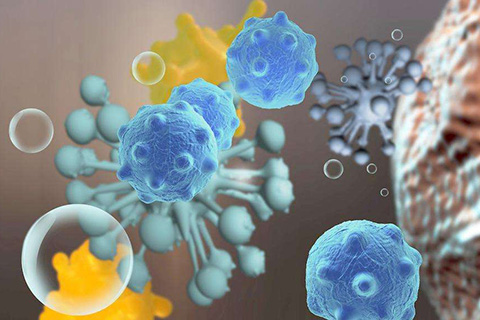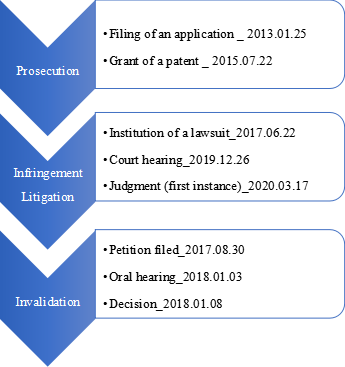Did not receive verification mail? Please confirm whether the mailbox is correct or not Re send mail

Vapor
- 2020-04-20 14:57:54
First case on infringement of a “microorganism” patent in China

The intellectual property protection of a microorganism is a hot topic in the field of biotechnology. Recently, Beijing Intellectual Property Court has concluded the first case on infringement of a patent which is directed to a microorganism. One of the focuses of this case is how to identify a commercially available strain is the same strain as claimed in the patent in suit and to determine the former falls within the scope of patent protection and thus constitutes infringement. This case explored the method for the identification of a microorganism strain in a patent trial, and could be influential in the identification of potential infringing products in patent cases involving a microorganism in the future. It has aroused the discussion and rethinking on the proper manner of protection on a microorganism. Further, the case demonstrates the enhanced patent protection in biotechnology field in China. This article will address the patent protection of a microorganism in connection with this case as well as alternative manners for the IP protection of a microorganism in current Chinese practice.
I.Brief introduction of patent in suit and associated administrative and judicial proceedings
1.Patent in suit
Certain microorganisms including fungi are highly valuable in agriculture and industry. Particularly, edible fungi are favorable choices in many people’s daily life. The patent in suit is Chinese Patent No. 201310030601.2 (published as CN103503780B), titled “a pure white Physicists murmurous strain.” The Patent is directed to a specific strain of edible fungi physicists marmoreus which is popular on the market. The patentee is Shanghai Fengke Biotechnology Co., Ltd. (hereinafter referred to as “Shanghai Fengke”). The claims as allowed include one claim, and what is claimed in the patent is as follows:
1. A pure white Hypsizigus marmoreus strain Finc-W-247, the deposit number of which is CCTCC NO:M2012378.
Namely, the patent in suit relates to a specific fungal strain (hereinafter referred to as “patented strain”) which is defined via deposit number. As indicated in the claim, the strain is deposited at a depository authority China Center for Type Culture Collection (“CCTCC”).
2.Overview on the proceedings of the case
The following graph shows the major proceedings of the case with some important time points indicated therein, which may provide a whole picture of the case up to now.

3.Patent infringement litigation
The Plaintiff Shanghai Kefeng sued two companies Tianjin Lvshengpengyuan Agricultural Science and Technology Development Co., Ltd. (hereinafter referred to as “Lvshengpengyuan”) and Tianjin Hongbinhesheng Agricultural Technology Development Co., Ltd. (referred to as “Hongbinhesheng”) as defendants for infringement of the Chinese Patent No 201310030601.2 before Beijing Intellectual Property Court (hereinafter referred to as “the Court”). A court hearing was held at December 26, 2019 and the case has now been concluded. In the proceedings of the litigation, strain identification is one of the key issues. According to the appraisal opinion of an appraisal institution, it was found that: 1) the internal transcribed spacer (ITS) rDNA sequences of the patent strain and the alleged infringing strain respectively have a sequence similarity of 99.9% to the ITS rDNA sequence of Hypsizigus marmoreus HMB1 (HM561968), and thus both of the patent strain and the alleged infringing strain belong to Hypsizigus marmoreus; 2) according to the sequence alignment of specific 975bpDNA fragments, the two specific 975bpDNA fragments were exactly the same from first to 975th nucleotides; and 3) according to morphological comparison, the morphological characteristics on the color, shape and arrangement of the cap, gill and stipe of the two strains are substantially the same. Based on the above findings, the appraisal panel concluded that the alleged infringing strain and the patent strain belong to the same strain. On March 17, 2020, the Court entered a judgment (2017) Jing 73 Minchu No. 555 (hereinafter referred to as the “judgment”), ordering the Defendants to stop infringement and awarding Shanghai Kefeng damages of two million RMB in total (1 million per one defendant) as well as approximately 84,000 RMB for compensating reasonable expenses of stopping the infringement.
II.Factors for consideration in the judgment of infringement on a “microorganism” patent
As set forth above, a microorganism is claimed in the patent in suit by defining the microorganism via deposit number. This is a typical way of claiming microorganisms in a patent. When determining whether the technical solution of the infringing product falls within the scope of patent protection, one shall compare all the technical features recited in the claim with the technical solution of the alleged infringing product. If the technical solution of the alleged infringing product includes technical features identical or equivalent to all of the technical features in the subject patent, it falls within the scope of patent protection.
In the judgment of the case, the Court held that: “the Patent seeks to protect a pure white Hypsizigus marmoreus, which belongs to a fungus. It is a kind of microorganism. Determining whether the alleged infringing product falls into the scope of patent protection, comparisons in terms of both morphological characteristics and molecular biological characteristics are indispensable.”
As mentioned before, in the aspect of morphological comparison, the alleged infringing product is substantially the same as the patent strain. The divergency between the parties mainly lies in the choice of identification methods on molecular biological characteristics.
For the selection of molecular biological identification methods, two kinds of identification methods, namely, whole genome sequencing and specific fragment sequencing, were addressed and compared in the judgment. The Court held that:
“[t]he patent seeks to protect a microorganism. For a microorganism, there is possibility for gene mutation. So even for the same microorganism, the gene sequence thereof may not be totally identical. For two microorganisms, it has not yet reached a consensus in this field on the level of sequence similarity which may serve as the standard for identifying two strains as the same. In fact, the sequence alignment of genes in microorganisms is relevant not only to the percentage of identity or similarity of the genes, but also to the interpretation and analysis of genes after sequencing. Because of the complexity of genome structure and the bias in sequencing processes, it is difficult to determine whether the two strains are the same microorganism according to the sequence similarity between the two. Therefore, it is held by the Court that there is uncertainty in the whole gene sequencing, which is insufficient to correctly reflect whether the alleged infringing product and the patent strain are the same kind of microorganism.”
Accordingly, as described above, in the judgment, sequencing and comparison on the specific fragment were applied to identify the microorganism strain.
As for molecular biological identification methods, the question that has been widely discussed is whether the DNA fragment of 975bp can be used as a specific DNA fingerprint to determine whether the alleged infringing product is the patent strain. Is it necessary to perform the whole genome sequencing for accurate comparison?
In view of the above issues, it is proposed by the author that, on the one hand, the status in the art may need to be considered; and on the other hand, the disclosure of the specification also needs to be taken into account.
Status in the art
In this case, the DNA fragment of 975bp is a kind of molecular marker, in particular, “SCAR molecular marker.” SCAR (Sequence-Characterized Amplified Region) is a marker technology established in 1993. Besides SCAR, there are also other DNA molecular markers based on PCR using specific primers, such as SSR, SRAP and TRAP. The issue of concern is the application of a molecular marker, particularly SCAR marker, for identification of a specific strain.
Upon a preliminary review on the relevant articles in the art, it appears that these techniques were applied to germplasm resources research and identification of microorganisms. Genetic diversity analysis of 12 Hypsizigus marmoreus strains by SRAP molecular marker(s) was reported, indicating that such markers are suitable for intraspecific identification of Hypsizigus marmoreus (Li Cuicui et al. 2009). SCAR marker technology has been used to identify a Lentinula edodes strain (Wu Xueqian et al., 2005) and a Pleurotus citrinopileatus strain (Xiong Fang et al., 2010). It can be seen that in this field, SCAR and other markers have been used to identify some fungi strain(s) within a species for around ten years.
Disclosure of the specification
It was described in a specific example in the specification that “SCAR (Sequence-Characterized Amplified Region) is a very stable molecular marker. Based on the sequencing of RAPD amplification products, a new pair of primers was designed to amplify DNA fragments that can be amplified by original primers. It is simple, rapid and stable for identification of strains. In this Example, the SCAR molecular marker of pure white Hypsizigus marmoreus strain Finc-W-247 was established, and the Finc-W-247 strain can be identified rapidly.” Further, it is described in the same example that “the specific DNA is the SCAR molecular marker of the Hypsizigus marmoreus strain Finc-W-247 of the present invention.” It appears that the feasibility of using the SCAR molecular marker for identification of the Hypsizigus marmoreus strain Finc-W-247 was verified through specific examples in the specification.
Based on the above, it seems that, in this case, the Court’s selection of the above specific 975bp DNA fragment for identification of the patented strain has a relatively reasonable technical basis.
In summary, from the opinion of the Court, we could see that in patent enforcement of microorganism patents, patentees are recommendable to collect evidences on the morphologic and molecular biological characteristics of potential infringing products, so as to prove that potential infringing products fall within the scope of patent protection.
III.Multiple manners of protection for microorganisms
In China, there are multiple possible ways of protecting certain microorganisms, for instance, via patents or via plant variety right.
1.Patent right
According to Article 25, Paragraph 1, Item 4, of the Patent Law of China, animal and plant varieties are not patent-eligible subject matter. Under the framework of the patent law, microorganisms are neither animal nor plant varieties, and thus are patent-eligible.
After the above patent lawsuit was filed by Shanghai Fengke, invalidation was requested against the patent in suit by the opponent on the grounds of insufficient disclosure and obviousness. Finally, the patent was maintained valid. From the judgment and invalidation decision, it can be seen that the description of the technical effects (including but not limited to morphological characteristics, biological characteristics, genetic characteristics, etc.) in the specification is of great significance for the establishment of inventive step and for the stability of patent right.
For the claims, it is also recommended to consider defining the microorganism as claimed from different aspects, for example, morphological features (e.g., color, shape) and/or molecular features (e.g., a specific sequence) can make enforcement more straightforward and predictable.
2.Plant variety right
In recent years, some fungi (e.g., Hypsizigus marmoreus) have been included in the directory of plant varieties for protection in China. Therefore, such fungi illuminated in the directory may also be protected by plant variety rights.
Summary and Prospective
In this article, the first case of infringement on a “microorganism” patent is briefly introduced and discussed. From this case, we could see that in the trial of the Court, the identification of a specific strain was made via the identification and comparison of morphological and molecular biological characteristics, with a specific DNA sequence as a molecular marker. It is desirable to pursue more theoretical and practical studies on related issues in the future. Some of the issues are worth further exploring and studying, for example, the suitability of selecting molecular markers for identification. With an assumption that a molecular marker is not recited in the specification of a patent, how to select molecular markers for identification of a strain? Is it necessary to conduct whole genome sequencing?
As for the protection of certain microorganisms, the value of a microorganism could be effectively realized through different categories of rights (such as patent right, plant variety right), and different levels of protection (for a patent, to draft claims with different scope, to set multiple layers of protection).
Finally, from the administrative proceedings in the case (such as grant of the patent right and patent invalidation) and judicial proceedings (such as patent infringement litigation), we could see that the efficiency is relatively high, and the court is attempting to find a reasonable and scientific way to balance the right of the patentee and the public. It is expectable that an increasingly effective and efficient IP protection system in China will encourage and protect innovation.
Source:www.iplink-asia.com
Author:Weiwei HAN
Editor:Vapor
- I also said the two sentence
- Also you can enter 140words






